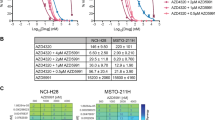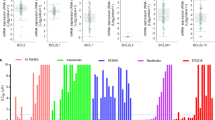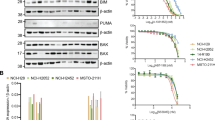Abstract
Increased expression of the cell proliferation-associated polo-like kinase 1 (PLK1) and apoptosis-associated BCL-2 genes has been observed in different human malignancies. Inhibition of cell proliferation and reactivation of apoptosis are basic principles in anticancer therapy. The efficiency of this approach is often limited by insuf-ficient targeting and delivery of anticancer drugs into the tumors. Phosphorothioate antisense oligodeoxynucleotides (ODNs) directed against PLK1 and BCL-2 were administered systemically via the tail vein into nude mice bearing A549, MDA-MB-435, and Detroit562 xenografts. To enhance tumor-specific uptake and to reduce systemic toxicity of antisense ODNs membrane electroporation transfer was applied in vivo. Northern and Western blot analyses were used to assess PLK1 and BCL-2 expression. Tumor mass was assessed after resection of tumors. All three cell lines and corresponding xenografts expressed high levels of PLK1 and were sensitive towards antisense PLK1 treatment. Antisense BCL-2 therapy was effective in tumors expressing high levels of BCL-2, but not in A549 cells and corresponding xenografts, which express low levels of BCL-2. Administration of antisense ODNs in a dose of 5 mg/kg, twice weekly during four weeks supported by the membrane electroporation transfer, eradicated 60–100% of the xenografted tumors. Antitumor effect in BCL-2 overexpressing MDA-MB-435 cells was synergistic for BCL-2 and PLK1 combination therapy. This study provides evidence that combined systemic administration of antisense ODNs against proliferation and pro- survival associated targets and in vivo electroporation of tumors represents a promising antitumor therapeutic approach.
This is a preview of subscription content, access via your institution
Access options
Subscribe to this journal
Receive 50 print issues and online access
$259.00 per year
only $5.18 per issue
Buy this article
- Purchase on Springer Link
- Instant access to full article PDF
Prices may be subject to local taxes which are calculated during checkout






Similar content being viewed by others
References
Agrawal S, Temsamani J and Tang JY . (1991). Pharmaco-kinetics, biodistribution, and stability of oligodeoxynucleotide phosphorothioates in mice. Proc. Natl. Acad. Sci. USA, 88, 7595–7599.
Antonsson B, Conti F, Ciavatta A, Montessuit S, Lewis S, Martinou I, Bernasconi L, Bernard A, Mermod JJ, Mazzei G etal. (1997). Inhibition of Bax channel-forming activity by BCL-2. Science, 277, 370–372.
Chan TA, Hermeking H, Lengauer C, Kinzler KW and Vogelstein B . (1999). 14-3-3 Sigma is required to prevent mitotic catastrophe after DNA damage. Nature, 401, 616–620.
Cogswell JP, Brown CE, Bisi JE and Neill SD . (2000). Dominant-negative polo-like kinase 1 induces mitotic catastrophe independent of cdc25C function. Cell Growth Diff., 11, 615–623.
Crooke ST and Lebleu B. (eds). (1993). Antisense Research and Applications. CRC Press: Boca Raton, FL.
Donaldson MM, Tavares AA, Hagan IM, Nigg EA and Glover DM . (2001). The mitotic roles of polo-like kinase. J. Cell Sci., 114, 2357–2358.
Draghia-Akli R, Fiorotto ML, Hill LA, Malone PB, Deaver DR and Schwartz RJ . (1999). Myogenic expression of an injectable protease-resistant growth hormone-releasing hormone augments long-term growth in pigs. Nat. Biotechnol., 17, 1179–1183.
Elez R, Piiper A, Giannini CD, Brendel M and Zeuzem S . (2000). Polo-like kinase 1, a new target for antisense tumor therapy. Biochem. Biophys. Res. Commun., 269, 352–356.
Golsteyn RM, Schultz SJ, Bartek J, Ziemiecki A, Ried T and Nigg EA . (1994). Cell cycle analysis and chromosomal localization of human PLK1 a putative homologue of the mitotic kinases Drosophila polo and Saccharomyces cerevisiae Cdc5. J. Cell Sci., 107, 1509–1517.
Grover R and Wilson GD . (1996). BCL-2 expression in malignant melanoma and its prognostic significance. Eur. J. Surg. Oncol., 22, 347–349.
Hamanaka R, Maloid S, Smith MR, O'Connell CD, Longo DL and Ferris DK . (1994). Cloning and characterization of human and murine homologues of the Drosophila polo serine–threonine kinase. Cell Growth Differ., 5, 249–257.
Heller R, Jaroszeski MJ, Glass LF, Messina JL, Rapaport DP, DeConti RC, Fenske NA, Gilbert RA, Mir LM and Reintgen DS . (1996). Phase I/II trial for the treatment of cutaneous and subcutaneous tumors using electrochemotherapy. Cancer, 77, 964–971.
Heller R, Jaroszeski MJ, Reintgen DS, Puleo CA, DeConti RC, Gilbert RA and Glass LF . (1998). Treatment of cutaneous and subcutaneous tumors with electrochemotherapy using intralesional bleomycin. Cancer, 88, 148–157.
Henry SP, Novotny W, Leeds J, Auletta C and Kornbrust DJ . (1997). Inhibition of coagulation by a phosphorothioate oligonucleotide. Antisense Nucleic Acid Drug Dev., 7, 503–510.
Holtrich U, Wolf G, Brauninger A, Karn T, Bohme B, Rubsamen-Waigmann H and Strebhardt K . (1994). Induction and down-regulation of PLK, a human serine/threonine kinase expressed in proliferating cells and tumors. Proc. Natl. Acad. Sci., USA 91, 1736–1740.
Jansen B, Schlagbauer-Wadl H, Brown BD, Bryan RN, Elsas A, Muller M, Wolf L, Eichler HG and Pehamberger H . (1998). BCL-2 antisense therapy chemosensitizes human melanoma in SCID mice. Nat. Med., 4, 232–234.
Jansen B, Wacheck V, Heere-Ress E, Schlagbauer-Wadl H, Hoeller C, Lucas T, Hoermann M, Hollenstein U, Wolff K and Pehamberger H . (2000). Chemosensitisation of malignant melanoma by BCL2 antisense therapy. Lancet, 356, 1728–1733.
Khaled Z, Benimetskaya L, Zeltser R, Khan T, Sharma HW, Narayanan R and Stein CA . (1996). Multiple mechanisms may contribute to the cellular anti-adhesive effects of phosphorothioate oligodeoxynucleotides. Nucleic Acids Res., 24, 737–745.
Knecht R, Elez R, Oechler M, Solbach C, von Ilberg C and Strebhardt K . (1999). Prognostic significance of polo-like kinase (PLK) expression in squamous cell carcinomas of the head and neck. Cancer Res., 59, 2794–2797.
Kotani S, Tugendreich S, Fujii M, Jorgensen PM, Watanabe N, Hoog C, Hieter P and Todokoro K . (1998). PKA and MPF-activated polo-like kinase regulate anaphase-promoting complex activity and mitosis progression. Mol. Cell, 3, 371–380.
Lake RJ and Jelinek WR . (1993). Cell cycle- and terminal differentiation-associated regulation of the mouse mRNA encoding a conserved mitotic protein kinase. Mol. Cell Biol., 13, 7793–7801.
Lane HA and Nigg EA . (1996). Antibody microinjection reveals an essential role for human polo-like kinase 1 (PLK1) in the functional maturation of mitotic centrosomes. J. Cell Biol., 135, 1701–1713.
Lee SE, Frenz LM, Wells NJ, Johnson AL and Johnston LH . (2001). Order of function of the budding-yeast mitotic exit-network proteins Tem1, Cdcl5, Mob1, Dbf2, and Cdc5. Curr. Biol., 11, 784–788.
Liotta L and Petricoin E . (2000). Molecular profiling of human cancer. Nat. Rev. Genet., 1, 48–56.
Minn AJ, Velez P, Schendel SL, Liang H, Muchmore SW, Fesik SW, Fill M and Thompson CB . (1997). Bcl-x(L) forms an ion channel in synthetic lipid membranes. Nature, 385, 353–357.
Mir LM, Belehradek M, Domenge C, Orlowski S, Poddevin B, Belehradek J Jr, Schwaab G, Luboinski B and Paoletti C . (1991). Electrochemotherapy, a new antitumor treatment: first clinical trial. C. R. Acad. Sci., 313, 613–618.
Mir LM and Reintgen DS . (1996). Phase I/II trial for the treatment of cutaneous and subcutaneous tumors using electrochemotherapy. Cancer, 77, 964–971.
Monia BP, Johnston JF, Geiger T, Muller M and Fabbro D . (1997). Antitumor activity of a phosphorothioate antisense oligodeoxynucleotide targeted against C-raf kinase. Nat. Med., 2, 668–675.
Neumann E, Kakorin S and Toensing K . (1999). Fundamentals of electroporative delivery of drugs and genes. Bioelectrochem. Bioenerg., 48, 3–16.
Neumann E, Kakorin S and Toensing K . (2000). Principles of membrane electroporation and transport of macromolecules. In: Jarosteki M J, Heller R, Gilbert R. (eds). Methods in Molecular Medicine, Vol. 37, Humana Press: Totowa, NJ, pp 1–35.
Neumann E, Schaefer-Ridder M, Wang Y and Hofschneider PH . (1982). Gene transfer into mouse lyoma cells by electroporation in high electric fields. EMBO J., 7, 841–845.
Ramchandani S, MacLeod AR, Pinard M, von Hofe E and Szyf M . (1997). Inhibition of tumorigenesis by a cytosine-DNA, methyltransferase, antisense oligodeoxynucleotide. Proc. Natl. Acad. Sci. USA. 9, 684–689.
Reed JC . (1995). Regulation of apoptosis by BCL-2 family proteins and its role in cancer and chemoresistance. Curr. Opin. Oncol., 7, 541–546.
Sambrook J, Fritsch EF and Maniatis T . (1989). Molecular Cloning: A Laboratory Manual. Cold Spring Harbor Lab. Press: Plainview, NY.
Sanchez Y, Bachant J, Wang H, Hu F, Liu D, Tetzlaff M and Elledge SJ . (1999). Control of the DNA damage checkpoint by chk1 and rad53 protein kinases through distinct mechanisms. Science. 285, 1166–1171.
Sheehan JP and Lan HC . (1998). Phosphorothioate oligonucleotides inhibit the intrinsic tenase complex. Blood 92, 1617–1625.
Smith MR, Wilson ML, Hamanaka R, Chase D, Kung H, Longo DL and Ferris DK . (1997). Malignant transformation of mammalian cells initiated by constitutive expression of the polo-like kinase. Biochem. Biophys. Res. Commun., 234, 397–405.
Smits VA, Klompmaker R, Arnaud L, Rijksen G, Nigg EA and Medema RH . (2000). Polo-like kinase-1 is a target of the DNA damage checkpoint. Nat. Cell Biol., 2, 672–676.
Stein CA . (1995). Does antisense exist? Nat. Med., 1, 1119–1121.
Swanson PE, Carroll SB, Zhang XF and Mackey MA . (1995). Spontaneous premature chromosome condensation, micronucleus formation, and non-apoptotic cell death in heated HeLa S3 cells. Ultrastructural observations. Am. J. Pathol., 146, 963–971.
Toyoshima-Morimoto F, Taniguchi E, Shinya N, Iwamatsu A and Nishida E . (2001). Polo-like kinase 1 phosphorylates cyclin B1 and targets it to the nucleus during prophase. Nature, 410, 215–220.
van Vugt MA, Smits VA, Klompmaker R and Medema RH . (2001). Inhibition of polo-like kinase-1 by DNA damage occurs in an ATM-/ATR-dependent fashion. J. Biol. Chem., 276, 41656–41660.
Wagner RW and Flanagan WM . (1997). Antisense technology and prospects for therapy of viral infections and cancer. Mol. Med. Today, 3, 31–38.
Wang H, Cai Q, Zeng X, Yu D, Agrawal S and Zhang R . (1999). Antitumor activity and pharmacokinetics of a mixed-backbone antisense oligonucleotide targeted to the RI alpha subunit of protein kinase A after oral administration. Proc. Natl. Acad. Sci. USA, 96, 13989–13994.
Wang Y and Becker D . (1997). Antisense targeting of basic fibroblast growth factor and fibroblast growth factor receptor-1 in human melanomas blocks intratumoral angiogenesis and tumor growth. Natl. Med., 3, 887–893.
Webb A, Cunningham D, Cotter F, Clarke PA, di Stefano F, Ross P, Corbo M and Dziewanowska Z . (1997). BCL-2 antisense therapy in patients with non-Hodgkin lymphoma. Lancet, 349, 1137–1141.
Wolf G, Elez R, Doermer A, Holtrich U, Ackermann H, Stutte HJ, Altmannsberger HM, Rubsamen-Waigmann H and Strebhardt K . (1997). Prognostic significance of polo-like kinase (PLK) expression in non-small cell lung cancer. Oncogene, 14, 543–549.
Acknowledgements
We thank Bert Vogelstein, Johns Hopkins Medical Institutions, Baltimore, for excellent discussions. This study was supported by grant Ze 237/4-2 of the Deutsche Forschungsgemeinschaft. We also thank Manfred Stegmüller for excellent support during the experiments.
Author information
Authors and Affiliations
Corresponding author
Rights and permissions
About this article
Cite this article
Elez, R., Piiper, A., Kronenberger, B. et al. Tumor regression by combination antisense therapy against Plk1 and Bcl-2. Oncogene 22, 69–80 (2003). https://doi.org/10.1038/sj.onc.1206038
Received:
Revised:
Accepted:
Published:
Issue Date:
DOI: https://doi.org/10.1038/sj.onc.1206038
Keywords
This article is cited by
-
Electrotransfer of single-stranded or double-stranded DNA induces complete regression of palpable B16.F10 mouse melanomas
Cancer Gene Therapy (2013)
-
Antiproliferative in vitro effects of BI 2536-mediated PLK1 inhibition on cervical adenocarcinoma cells
Clinical and Experimental Medicine (2013)
-
Plk1-Targeted Small Molecule Inhibitors: Molecular Basis for Their Potency and Specificity
Molecules and Cells (2011)
-
Plasmid injection and application of electric pulses alter endogenous mRNA and protein expression in B16.F10 mouse melanomas
Cancer Gene Therapy (2010)
-
The natural product Aristolactam AIIIa as a new ligand targeting the polo-box domain of polo-like kinase 1 potently inhibits cancer cell proliferation
Acta Pharmacologica Sinica (2009)



